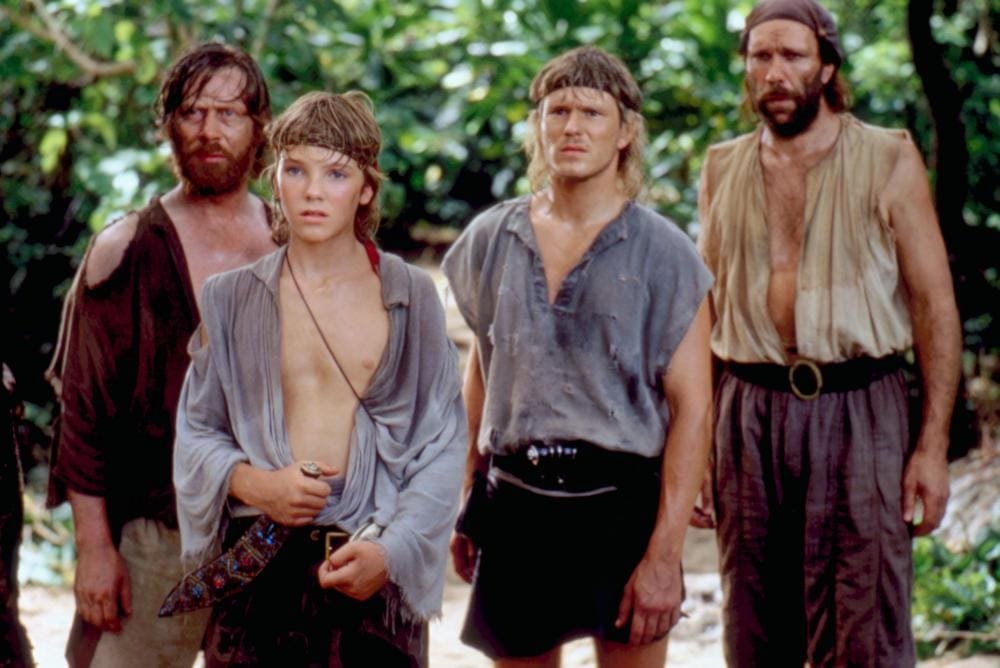Review: Shipwrecked (1990)
For those who enjoy a good boys’ own adventure but who have exhausted the classics on film—Treasure Island (1950), Swiss Family Robinson (1960), etc.—Shipwrecked will come as a pleasant surprise. That is, unless you are a millennial who happened to catch this Scandinavian picture about seafaring, piracy, and survival on a tropical island back in the early 1990s, when Walt Disney released the movie for English markets. In that case, you’ll be happy to discover that Shipwrecked holds up as a well-made children’s adventure.
Directed by Sámi filmmaker Nils Gaup and based on a Norwegian book from 1873 (Oluf Falck-Ytter’s Haakon Haakonsen: En norsk Robinson, “A Norwegian Robinson”), Shipwrecked was a Scandinavian production distributed by Disney. In the Scandinavian version, the Norwegian characters speak Norwegian to each other and English to English characters, whereas the Disney release dubs all the dialogue into English. I watched the dub, and it was so competent that I didn’t notice it.
Shipwrecked is the tale of young Haakon Haakonsen (Stian Smestad), who lives on a poor farm in Norway. When his sailor father returns from sea with an injury that prevents him from working any more, the family farm is threatened by a money lender. Haakon decides to save his family’s livelihood by taking on a commission as a cabin boy. His father’s friend, the young man Jens (Trond Peter Stamsø Munch), will watch over Haakon, as he learns the tough work of being a sailor. On board, Haakon works hard and soon wins over the captain (Kjell Stormoen) and crew. Eventually, he will discover and take care of a stowaway girl (Louisa Milwood-Haigh).
When the ship is commissioned to sail to Calcutta by way of Sydney, the captain takes on a Royal Navy officer played by Gabriel Byrne to protect the ship during its passage through pirate-frequented waters. Like the deceptive cook Long John Silver in Treasure Island, Byrne’s officer is actually a notorious pirate captain, John Merrick. He and his wicked mates take over the ship, but the vessel soon goes under during a big storm, and Haakon wakes up on a deserted tropical island—the very one to which Merrick was hoping to return in order to fetch his buried treasure. On the island, Haakon learns to fend for himself and builds plenty of booby traps for when the pirates return for the inevitable face-off.
As you can read, Shipwrecked contains all the ingredients that you would expect in this sort of tale. While the story offers little that is unfamiliar, except the novel Norwegian twist for English audiences, the film is recommended for its sturdy production, serious depiction of dramatic events, and fine principal photography using real locations and a real ship. The fact that we are getting shots of characters on a real longship at sea, or of a boy on a real tropical island with white sand beaches (shot in Fiji) gives the film a lasting appeal that CGI productions so easily lose. My only gripe about the production is the inclusion of a man in a gorilla costume, which looks poor and adds little to the plot.
I would also add that some strong performances set Shipwrecked apart from many children’s adventures. As the prepubescent Haakon, Smestad generates genuine emotion, such as when he dutifully decides to go to sea to save his family or when he faces isolation and homesickness on the island. Byrne plays his villain as someone ruthless and cruel hiding in plain sight, avoiding any vestiges of pirate mannerisms (“Yarr, matey”) à la Robert Newton’s famous Long John Silver in the 1950 Disney production of Treasure Island. We believe and fear Merrick when he says he wants to keelhaul and whip the boy for harbouring a stowaway.
Shipwrecked is a competent adventure for children, played without irony, revisionism, or computer-generated fakeness. Viewed today, all that seems like a real treasure.
7 out of 10
Shipwrecked (1990, Norway/Sweden/USA)
Directed by Nils Gaup; screenplay by Nils Gaup, Bob Foss, Greg Dinner, and Nick Thiel, based on the novel by O. V. Falck-Ytter; starring Stian Smestad, Gabriel Byrne, Trond Peter Stamsø Munch, Louisa Milwood-Haigh, and Kjell Stormoen.



28 Weeks Later is by no means a bad sequel, but it lacks the original film’s impact.